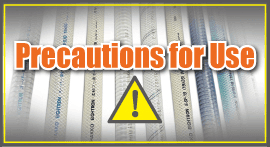Question 23: What is the difference between "Anti-Static" and "Conductivity"?
May 10,2025 General Questions about Hose/Tube/Fittings
Answer 23: "Anti-Static" [10<sup>9</sup> to 10<sup>13</sup>] means the ability to prevent the static electricity from accumulating. On the other hand, "Conductivity" [10<sup>3</sup> to 10<sup>5</sup>] means the ability of an object to conduct the electricity. Compared to anti-static properties, "Conductivity" allows the static electricity to be dissipated instantly due to its low resistance. Simply put, "Conductivity" ...
Question 22: Can SUS fittings be used for food and beverage applications?
May 10,2025 General Questions about Hose/Tube/Fittings
Answer 22: Yes. The Japanese Food Sanitation Law specifies the regulations for copper, lead, and their alloys in utensils, with lead content limited to 0.1% or less in tin used for plating, manufacturing, or repairing metal, and 5% or less in antimony. Since SUS is a material, specified in the JIS standards as containing neither ...
Question 21: Our equipment is originally from the United States and the UK. Could you please inform the screw thread standards?
March 15,2025 General Questions about Hose/Tube/Fittings
Answer: The thread made in Japan is based on ISO Standard. ISO Standard is compatible with BS Standard (UK Standard). However, NPT Standard (US Standard) is NOT compatible with ISO/BS Standards.
Question 20: How do we select a suitable product when two or more chemicals are mixed?
August 25,2024 General Questions about Hose/Tube/Fittings
Answer 20: If two or more chemicals are mixed, the chemical resistance chart is not reliable. (We are not sure about how two or more chemicals affect the material A.) Thus, we strongly recommend you to obtain the sample and test it in the application. Please request a sample here.
Question 19: Do you have the information on the recommended outer diameter size of fittings for hose inner diameter size of I.D. 12mm (for instance)?
June 25,2022 General Questions about Hose/Tube/Fittings
Answer 19: First of all, we always recommend you to use our original fittings, as the matching between our hose and fittings is guaranteed. However, in case you have no choice but to use the fittings produced by other manufacturers, our recommendation is that a fitting outer diameter size should be about 5-15 % bigger ...
Question 1: What is "SDS" ("MSDS")?
November 12,2018 Regulations and Certificate
Answer 1: "SDS" ("MSDS") stands for "(Material) Safety Data Sheet." "Safety Data Sheet" is a material-based datasheet. If you need "SDS" ("MSDS"), please send your inquiry from here.
Question 1: What is the lifetime of hose/tube?
June 02,2018 General Questions about Hose/Tube/Fittings
Answer 1: We are afraid that we cannot set the general lifetime, since the lifetime of the hose heavily depends on using conditions and using environments. If you find the following features, we strongly recommend that it is time to replace into a new hose. ...Tear, Scratches, swelling, crack, curve, deformation, and exposure of reinforced ...
Question 2: Our customers request a certificate of RoHS 2 compliance. Can we obtain?
November 12,2018 Regulations and Certificate
Answer 2: Yes, we can issue a certificate of RoHS 2 compliance. Please click here.
Question 3: Our customers request a certificate of REACH or SVHC compliance. Can we obtain?
November 12,2018 Regulations and Certificate
Answer 3: Yes, we can issue a certificate of REACH or SVHC. Please fill out the form from below.
Question 4: When we export HAKKO products to foreign countries, the certificate of non-applicability is required. Could you please issue this certificate?
November 12,2018 Regulations and Certificate
Answer 4: Yes, we can issue this certificate upon request. Please send your request from this form.










